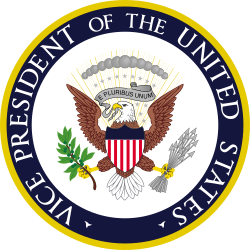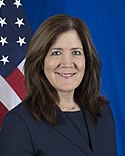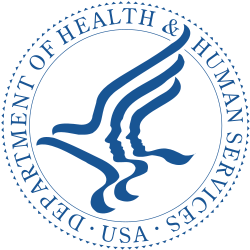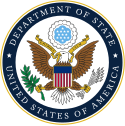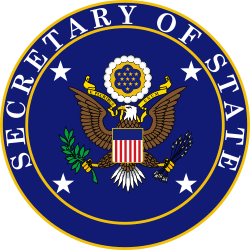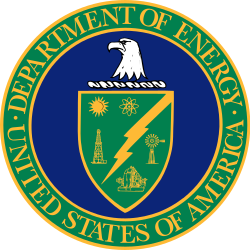Kabinet Spojených států amerických
| Kabinet Spojených států amerických Cabinet of the United States | |
|---|---|
 | |
 | |
| Prezident | Donald Trump |
| Počet členů | viceprezident 15 ministrů další funkcionáři |
| Webová stránka | www.whitehouse.gov |
| Některá data mohou pocházet z datové položky. | |
Kabinet Spojených států amerických (anglicky Cabinet of the United States, česky také: vláda Spojených států amerických[1][2][3]) je součástí výkonné větve Federální vlády Spojených států amerických. Kromě postu viceprezidenta není kabinet výslovně ukotven v Ústavě.[4] Její 2. článek předpokládá, že si prezident pořizuje poradní sbor.[pozn. 1] XXV. dodatek Ústavy umožňuje viceprezidentovi s podporou většiny členů vlády prohlásit prezidenta nezpůsobilým výkonu funkce.[pozn. 2] Navíc Ústava vyžaduje souhlas Senátu Spojených států, tedy horní komory Kongresu, se jmenováním člena vlády. Volený viceprezident schválení Senátem nepodléhá. Kabinet zasedá v Bílém domě ve Washingtonu D.C., v oficiálním sídle prezidenta v tzv. Cabinet Room.
Historie
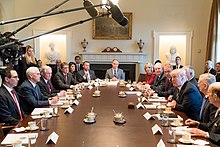
Jednotliví členové vlády, kromě prezidenta, viceprezidenta a uvedených poradců, vedou ministerstva, tzv. departmenty. Ústava nestanoví, kolik má být ministerstev a jaké mají být jejich pravomoci. Prvním prezidentem, který si poradní sbor zformoval do systému ministerstev, byl George Washington. Jeho vláda měla jen čtyři členy: ministr zahraničí Thomas Jefferson, ministr financí Alexander Hamilton, ministr války Henry Knox a ministr spravedlnosti Edmund Randolph. Viceprezident John Adams nebyl členem Washingtonova kabinetu, protože post viceprezidenta byl v počátcích Spojených států amerických (a ještě v 19. století) vnímán jako součást legislativní moci. Původně viceprezident předsedal Senátu a byl vnímán především jako nástupce prezidenta v případě jeho úmrtí či nezpůsobilosti vykonávat funkci. Až ve 20. století začali být viceprezidenti zařazováni do kabinetů. Formálně, jakožto virilista, je viceprezident předsedou Senátu, byť jej fakticky neřídí a při rovnosti má rozhodující hlas.
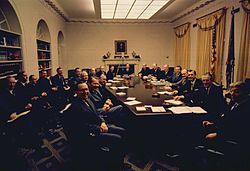
V celé historii Spojených států amerických však Senát odmítl jen devět nominantů prezidenta na ministra. Ve 20. století se to stalo třikrát, naposledy roku 1989, kdy Senát odmítl potvrdit Johna Towera do funkce ministra obrany kvůli jeho opilství, promiskuitě a vztahy s výrobci zbraní. Senát schvaluje ministra prostou většinou. Naopak při odvolávání ministra není prezident limitován žádnou jinou mocí a v tomto smyslu je kabinet stále jen sborem poradců, což bylo potvrzeno rozhodnutím Nejvyššího soudu Spojených států z roku 1926 v případu Myers versus Spojené státy americké. Ministr může být rovněž odvolán na základě žaloby Sněmovny reprezentantů (tzv. impeachment) a následného verdiktu Senátu, a to za „zradu, úplatkářství nebo jiné vážné zločiny“ (2. článek Ústavy). Prezident může také jmenovat za členy kabinetu své poradce z Výkonné kanceláře prezidenta a vedoucí federálních agentur, i když jim to per se nepropůjčuje žádné další pravomoce, krom možnosti účastnit se schůzí vlády.
Pravomoci
V americkém prezidentském systému nemá kabinet postavení kolektivního rozhodovacího orgánu, nýbrž jde o poradní sbor prezidenta. Prezident však může některého ze členů kabinetu výkonem svých pravomocí pověřit.[5][6] V minulosti existovaly pokusy postavení ministrů vůči prezidentovi posílit po vzoru parlamentních systémů. Hlavní tažení za tímto účelem vedl v polovině 19. století ministr zahraničí William H. Seward, avšak prezident Abraham Lincoln tyto snahy rázně utnul. Zastáncem parlamentního modelu, před svým vstupem do politiky, byl i právník a politolog Woodrow Wilson, avšak jakmile se stal prezidentem, své postavení na úkor ministrů nijak neoslabil. Prezident Ronald Reagan zavedl systém sedmi vládních rad, které přezkoumávají vládní rozhodnutí, používaný dodnes.
Kabinet má však jednu významnou pravomoc pro mimořádné případy, která byla zavedena v roce 1967 přijetím 25. dodatku ústavy. Podle 4. oddílu tohoto dodatku může „viceprezident a bud' většina vedoucích sekcí exekutivy, nebo jiného takového útvaru, který může Kongres zákonem zřídit“ předat předsedům komor Kongresu prohlášení o tom, že prezident není způsobilý vykonávat pravomoci a povinnosti svého úřadu; následně by se pak viceprezident ujal pozice úřadujícího prezidenta. Toto opatření bylo zavedeno pro případ, že by prezident byl například vlivem nemoci nebo atentátu ve stavu, kdy nezemřel ale zároveň není schopen rozhodnout (např. kóma).[7]
Vláda Donalda Trumpa
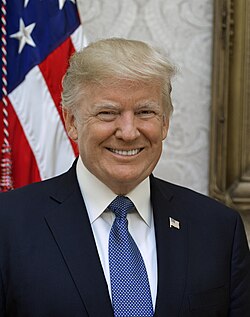
Druhou prezidentskou přísahu složil Donald Trump 20. ledna 2025 a ujal se úřadu. Všechny členy vlády, vyjma viceprezidenta J. D. Vance, navrhl prezident do úřadů, s jejich nutným potvrzením Senátem Spojených států. Pouze volený viceprezident a ředitel kanceláře Bílého domu nepodléhali senátnímu schválení.
Viceprezident a ministři
Vládu tvoří viceprezident a členové kabinetu stojící v čele federálních úřadů výkonné moci – ministerstev, seřazených podle linie nástupnictví do úřadu prezidenta. Někteří další členové administrativy mají postavení na úrovni vlády.
| Vláda Donalda Trumpa | ||
|---|---|---|
| Úřad | člen vlády | nástup do úřadu |
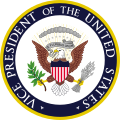 Viceprezident |  J. D. Vance | 20. ledna 2025 |
 Ministr zahraničních věcí |  Marco Rubio | 21. ledna 2025 |
 Ministr financí |  Scott Bessent | 28. ledna 2025 |
 Ministr obrany |  Pete Hegseth | 25. ledna 2025 |
Ministryně spravedlnosti |  Pam Bondiová | 5. února 2025 |
Ministr vnitra |  Doug Burgum | 31. ledna 2025 |
 Ministryně zemědělství |  Brooke Rollinsová | 13. února 2025 |
Ministr obchodu |  Howard Lutnick | 21. února 2025 |
 Ministryně práce |  Lori Chavez-DeRemerová | 11. března 2025 |
 Ministr zdravotnictví a sociální péče |  Robert F. Kennedy Jr. | 13. února 2025 |
 Ministr bytové výstavby a rozvoje měst |  Scott Turner | 6. února 2025 |
 Ministr dopravy |  Sean Duffy | 28. ledna 2025 |
Ministr energetiky |  Chris Wright | 4. února 2025 |
 Ministryně školství |  Linda McMahonová | 3. března 2025 |
 Ministr pro záležitosti veteránů |  Doug Collins | 5. února 2025 |
 Ministryně vnitřní bezpečnosti |  Kristi Noemová | 25. ledna 2025 |
Členové administrativy na úrovni vlády
| Členové administrativy na úrovni vlády | ||
|---|---|---|
| Úřad | člen na úrovni vlády | nástup do úřadu |
 Ředitel Agentury pro ochranu životního prostředí |  Lee Zeldin | 29. ledna 2025 |
 Ředitel Úřadu pro správu a rozpočet |  Russell Vought | 7. února 2025 |
 Ředitelka tajných služeb |  Tulsi Gabbardová | 12. února 2025 |
 Ředitel Ústřední zpravodajské služby |  John Ratcliffe | 23. ledna 2025 |
 Vládní zmocněnec pro obchod |  Jamieson Greer | 27. února 2025 |
 Velvyslankyně při OSN |  Dorothy Sheaová (chargé d’affaires) | 20. ledna 2025 |
Ředitelka Úřadu pro drobné podnikání |  Kelly Loefflerová | 20. února 2025 |
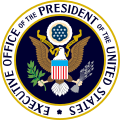 Ředitelka kanceláře Bílého domu |  Susie Wilesová | 20. ledna 2025 |
Další vysoké pozice v administrativě
- Poradce pro otázky národní bezpečnosti
- Ředitel Agentury pro klimatickou změnu
Poznámky
- ↑ V druhém oddílu Ústavy je obsažena věta „prezident může vyžadovat písemná vyjádření od vedoucích úředníků všech sekcí federální správy o všech otázkách týkajících se jejich úřadu“.
- ↑ Ve čtvrtém oddílu je uvedena formulace „většina vedoucích sekcí exekutivy, nebo jiného takového útvaru, který může Kongres zákonem zřídit“.
Reference
V tomto článku byl použit překlad textu z článku Cabinet of the United States na anglické Wikipedii.
- ↑ ČTK. USA chtějí snížit strop pro přijímání uprchlíků na 18 tisíc. V roce 2017 legálně přišlo na 100 tisíc lidí. iROZHLAS [online]. Český rozhlas, 2019-09-27 [cit. 2019-10-23]. Dostupné online.
- ↑ ČTK. Vláda Spojených států se chystá uvalit další cla na dovoz z Číny. Týden.cz [online]. 2018-10-30 [cit. 2019-10-23]. Dostupné online.
- ↑ ČTK. ‚Vláda Spojených států zavírá, Kuba otevírá,‘. Ostrov usnadní svým občanům cesty do vlasti. Lidovky.cz [online]. 2017-10-29 [cit. 2019-10-23]. Dostupné online.
- ↑ ÚSTAVA SPOJENÝCH STÁTŮ AMERICKÝCH [online]. [cit. 2023-09-10]. Dostupné online.
- ↑ U.S. Code, Title 3 §301: General authorization to delegate functions; publication of delegation [online]. [cit. 2024-05-21]. Dostupné online.
- ↑ Participation of the Vice President in the Affairs of the Executive Branch [online]. Ministerstvo spravedlnosti Spojených států amerických [cit. 2024-05-21]. Dostupné online.
- ↑ Ústava Spojených států amerických [online]. [cit. 2020-04-09]. Dostupné online.
Externí odkazy
 Obrázky, zvuky či videa k tématu Kabinet Spojených států amerických na Wikimedia Commons
Obrázky, zvuky či videa k tématu Kabinet Spojených států amerických na Wikimedia Commons - Kabinet Spojených států amerických – oficiální stránky (anglicky)
Média použitá na této stránce
Seal of the Vice President of the United States. The blazon is defined in Executive Order 11884 as:
The design is the same as the Seal of the President of the United States, except that there is no ring of stars, the clouds are gray (instead of proper), the stars are gray (instead of argent), the scroll is gray (instead of white), the arrows are gray (instead of proper), and the background colors and inscription (obviously) differ.The Coat of Arms of the Vice President of the United States shall be of the following design:
SHIELD: Paleways of thirteen pieces argent and gules, a chief azure; upon the breast of an American eagle displayed holding in his dexter talon an olive branch proper and in his sinister a bundle of thirteen arrows gray, and in his beak a gray scroll inscribed "E PLURIBUS UNUM" sable.
CREST: Behind and above the eagle a radiating glory or, on which appears an arc of thirteen cloud puffs gray, and a constellation of thirteen mullets gray.
The Seal of the Vice President of the United States shall consist of the Coat of Arms encircled by the words "Vice President of the United States."
Autor: unknown, Licence:
Official full portrait of Scott Turner as Executive Director of the White House Opportunity and Revitalization Council, reused as portrait for his role as the 19th Secretary of Housing and Urban Development.
Seal of the United States Department of Homeland Security. A graphically styled American eagle appears in a circular blue field. The eagle's outstretched wings break through an inner red ring into an outer white ring that contains a circular placement of the words "U.S. DEPARTMENT OF" in the top half and "HOMELAND SECURITY" in the bottom half. The outer white ring has a silvery gray border. As in The Great Seal, the eagle’s left claw holds an olive branch with 13 leaves and 13 seeds while the right claw grasps 13 arrows. Centered on the eagle's breast is a shield divided into three sections containing elements that represent the homeland "from sea to shining sea." The top element, a dark blue sky, contains 22 stars representing the original 22 agencies and bureaus that have come together to form the department. The left shield element contains white mountains behind a green plain underneath a light blue sky. The right shield element contains four wave shapes representing the oceans, lakes and waterways alternating light and dark blue separated by white lines.
Seal of the United States Department of Housing and Urban Development.
The seal was originally unveiled on November 10, 1966, and later defined in law (Federal Register 32FR366-67 and 24 CFR subtitle A, §11.1, both since removed as part of a streamlining of the federal code). The seal was defined as:
On a white background within a circle composed of the words, "U.S. Department of Housing and Urban Development," is an eagle and two stars. The six upper bars depicting the upper portion of the eagle's wings, the torso of the eagle, the star at the right of the eagle, and the words, "U.S. Department of Housing and Urban Development," are colored blue. The eight lower bars depicting the lower portion of the eagle's wings and the star at the left of the eagle are colored green."
The seal is a representative of high rise buildings simulating an eagle and giving emphasis to the "urban" in HUD's name. The eagle (shown abstractly) is a symbol of Federal authority. The use of green symbolizes open space, land, growth and prosperity. The blue in the Seal alludes to the quality of life and environment in America's cities.
More information here.Official portrait of the Director of National Intelligence, Tulsi Gabbard
The seal of the United States Department of the Treasury.
The original seal dates from the Board of Treasury during the Articles of Confederation, and so predates the department (and Federal Government) itself. The current design is a slight simplification of the original, introduced in 1968.
The seal's arms depicts balancing scales (to represent justice), a key (the emblem of official authority) and a chevron with thirteen stars (to represent the original states).
For more information, see here.President Donald J. Trump hosts Prime Minister Narendra Modi of India at the White House
Seal of the United States Department of Justice.
The origins of the seal are unknown; it was first used in the 19th century as the seal for the Office of the Attorney General (prior to the formation of the Department of Justice) but the exact date is unknown. Even the translation of the Latin motto is murky, a matter of debate between Latin scholars. The Department's currently accepted translation is who prosecutes on behalf of Lady Justice, referring to the Attorney General. The motto is an allusion to the wording of the writ in a qui tam action: qui tam pro domino rege quam pro se ipso sequitur ("he who sues on behalf of our lord the King as well as for himself." The current-day seal dates from 1934, when some (though not all) of the heraldic mistakes on the original were corrected. More information here.Seal of the United States Department of Education.
The seal was introduced on May 7, 1980, and is described in law as:More information here and 34 CFR Part 3.Standing upon a mound, an oak tree with black trunk and limbs and green foliage in front of a gold rising sun, issuing gold rays on a light blue disc, enclosed by a dark blue border with gold edges bearing the inscription "DEPARTMENT OF EDUCATION" above a star at either side of the words "UNITED STATES OF AMERICA" in smaller letters in the base; letters and stars in white.
Seal of the US Environmental Protection Agency (EPA).
Portait of Secretary of the Interior Doug Burgum, 2025
Pam Bondiová v roce 2025
Seal of the United States Secretary of State, as shown in raster source. Redrawn using elements from the Seal of the United States Department of State.
First photo session with Richard M. Nixon's first term cabinet in the cabinet room.
This morning, I welcomed Canadian Minister of Transport @AnitaAnandMP to our @USDOT headquarters to discuss our efforts for travel safety across our shared border.
Official portrait of Scott Bessent, treasury secretary of the United States.
President Donald Trump poses for his official portrait at The White House, in Washington, D.C., on Friday, October 6, 2017. (Official White House Photo by Shealah Craighead)
29th Secretary of Defense Pete Hegseth Official Portrait (DoD photo by Chad J. McNeeley)
The creation of the new Department of Veterans Affairs in 1989 required a new official seal to represent VA. In November 1988, after the law establishing VA as a cabinet department was signed, VA initiated a competition among employees for a seal design that would give the new department a "new look." The winner of that competition, and creator of today's VA seal was David E. Gregory, a medical media production specialist at the Indianapolis VA Medical Center. These are the key elements of the seal, as he described them:
- The eagle represents the United States.
- The circle of five stars above the eagle represents the Army, Navy, Air Force, Marines and Coast Guard.
- The two flags in the eagle's talons represent the span of America's history from 13 colonies to the present 50 states.
- The flags are bound by a golden cord symbolic of those Americans who have fallen in service to their country.
- The eagle holds the cord to perpetuate the memory of those veterans who have fallen and sacrificed for the nation.
Official portrait of the 17th United States Secretary of Energy, Chris Wright
Official portrait of Douglas "Doug" Collins, United States Secretary of Veterans Affairs
Official portrait of US Secretary of State Marco Rubio
Seal of the United States Department of the Interior.
The seal consists of a male bison with the head and body in a left position, standing on a prairie, with mountains and a rising sun in the background, enclosed within two concentric circles, having the words "U.S. Department of the Interior" and the date "March 3, 1849" (when Congress created the department) inscribed in the top and bottom arcs within these circles. See here for more information.
The bison seal dates from 1917, when it was used as the emblem on the initial department flag and thereafter replaced the old version of the seal, which used a federal eagle. The eagle was reinstated for a few years in the 1920s, and a different seal was used from 1968-69, but on both occasions the bison seal was reinstated. For more information see this chapter in The Department of Everything Else: Highlights of Interior History."From this day on, the United States of America will be a free, sovereign and independent nation. We will stand bravely. We will live proudly. We will dream boldly, and nothing will stand in our way." –President Donald J. Trump
Lee Zeldin, the 17th Administrator of the Environmental Protection Agency
Official portrait of Kelly Loeffler, administrator of the Small Business Administration.
U.S. Department of Agriculture (USDA) Secretary Sonny Perdue meets with U.S. Trade Representative (USTR) Robert E. Lighthizer, in Washington, D.C., on Dec 17, 2018. Supporting Secretary Perdue are Under Secretary for Trade and Foreign Agricultural Affairs Ted McKinney, Chief of Staff Ray Starling, and USDA Foreign Agricultural Service (FAS) Administrator Ken Isley. Supporting U.S. Trade Representative Robert E. Lighthizer are Deputy US Trade Representative Ambassador CJ Mahoney, Chief Agricultural Negotiator Ambassador Gregg Doud, Jamieson Greer, Chief of Staff to the US Rep, Stephen Vaughn (General Counsel), Sharon Bomer, and Leslie Yang. USDA Photo by Tomasina Brown.
Russ Vought, Office of Management and Budget's Deputy Director
Seal of the United States Department of Commerce.
The seal was approved on April 4, 1913 and is derived from the seal of the defunct United States Department of Commerce and Labor. It is composed of the arms (Per fesse azure and or, a ship in full sail on waves of the sea, in chief proper; and in base a lighthouse illumined proper), and crest ("The American Eagle displayed"). Around the arms, between two concentric circles, are the words "Department of Commerce" and "United States of America".
The official symbolism has been modified as the functions of the department have changed. As of 2007: the ship is a symbol of commerce; the blue denotes uprightness and constancy; the lighthouse is a well-known symbol representing guidance from the darkness which is translated to commercial enlightenment; and the gold denotes purity. The crest is the American bald eagle denoting the national scope of the Department's activities.
Full description at CFR Title 15 Part 1A photo of Howard Lutnick, then the nominee for United States Secretary of Commerce, taken by photographer and film director Daniel Torok. (January 17, 2025)
U.S. Secretary of Agriculture Brooke Rollins, USDA official portrait on Feb. 14, 2025. (USDA photo by Christophe Paul)
First meeting of the Cabinet of Donald Trump in the White House
Autor: Office of the Governor, South Dakota, Licence: CC BY 4.0
Second Portrait of Governor Kristi Noem
Seal of the C.I.A. - Central Intelligence Agency of the United States Government.
Seal of the Office of the Director of National Intelligence. See more information: [1]
Linda McMahon's official photo as the Administrator of the Small Business Administration.
2014 Seal of the Executive Office of the President of the United States
Seal of the Vice President of the United States. The blazon is defined in Executive Order 11884 as:
The design is the same as the Seal of the President of the United States, except that there is no ring of stars, the clouds are gray (instead of proper), the stars are gray (instead of argent), the scroll is gray (instead of white), the arrows are gray (instead of proper), and the background colors and inscription (obviously) differ.The Coat of Arms of the Vice President of the United States shall be of the following design:
SHIELD: Paleways of thirteen pieces argent and gules, a chief azure; upon the breast of an American eagle displayed holding in his dexter talon an olive branch proper and in his sinister a bundle of thirteen arrows gray, and in his beak a gray scroll inscribed "E PLURIBUS UNUM" sable.
CREST: Behind and above the eagle a radiating glory or, on which appears an arc of thirteen cloud puffs gray, and a constellation of thirteen mullets gray.
The Seal of the Vice President of the United States shall consist of the Coat of Arms encircled by the words "Vice President of the United States."
Official portrait of Robert F. Kennedy Jr., the United States secretary of health and human services.
Autor: Shawnmoore, Licence: CC BY-SA 4.0
12 March 2025 - Washington, DC - U.S. Secretary of Labor Lori M. Chavez-DeRemer
- Official Department of Labor Photograph***
Photographs taken by the federal government are generally part of the public domain and may be used, copied and distributed without permission. Unless otherwise noted, photos posted here may be used without the prior permission of the U.S. Department of Labor. Such materials, however, may not be used in a manner that imply any official affiliation with or endorsement of your company, website or publication.
Photo Credit: Department of Labor
Shawn T MooreSeal of the United States Office of Management and Budget. It is described in Executive Order 11600 as:
On a blue disc, the Arms of the United States proper above a curved gold scroll inscribed "OFFICE OF MANAGEMENT AND BUDGET", in black raised letters, all within a white border edged gold and inscribed "EXECUTIVE OFFICE OF THE PRESIDENT OF THE UNITED STATES", in blue raised letters. Dark blue suggested by the Seal of the President denotes the direct organizational link with the Presidential office. The arms of the United States refer to the entire Nation and represent the Office's involvement in the organizational and technological processes necessary to assist the President in his role as Chief Executive of the United States.
